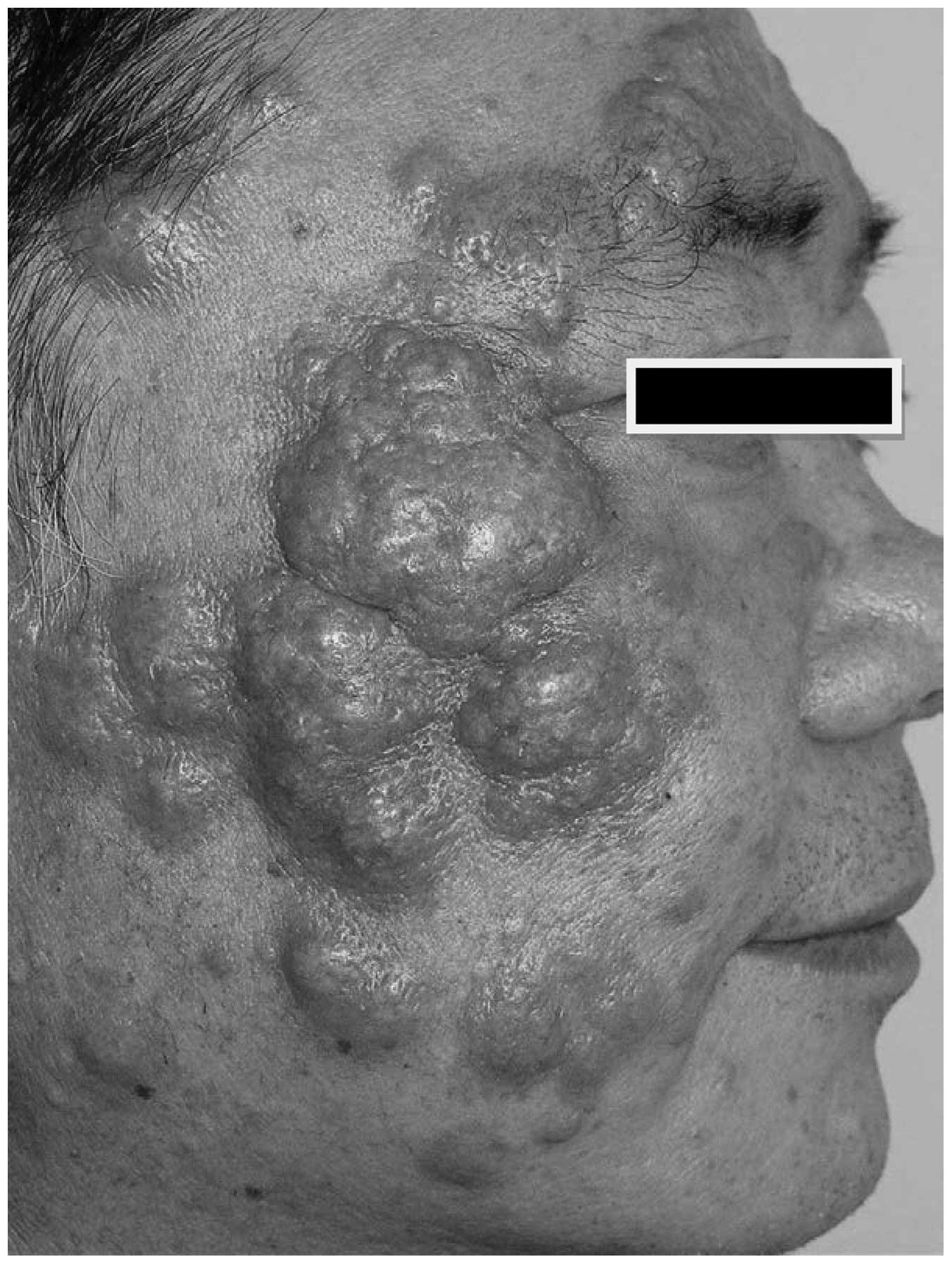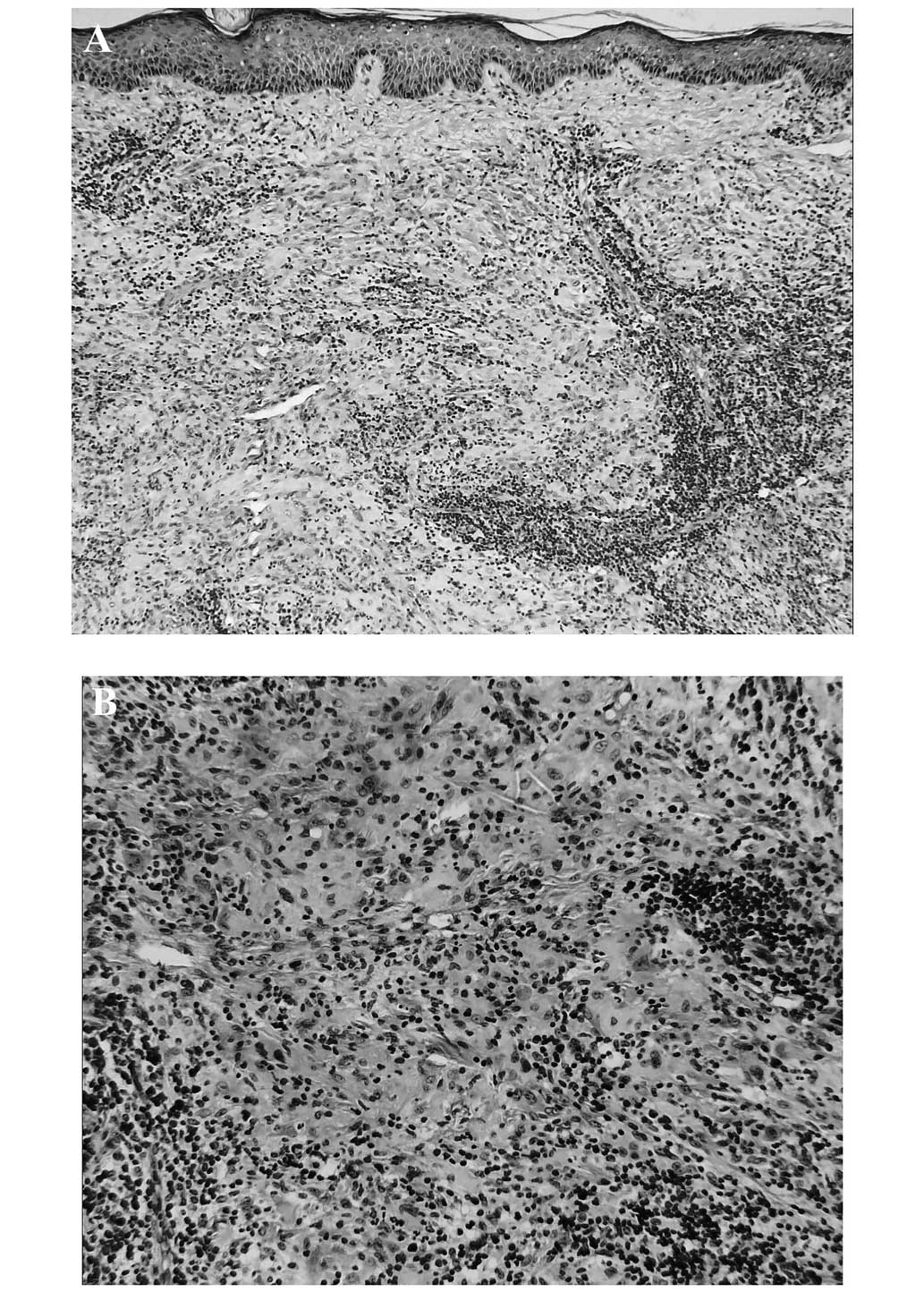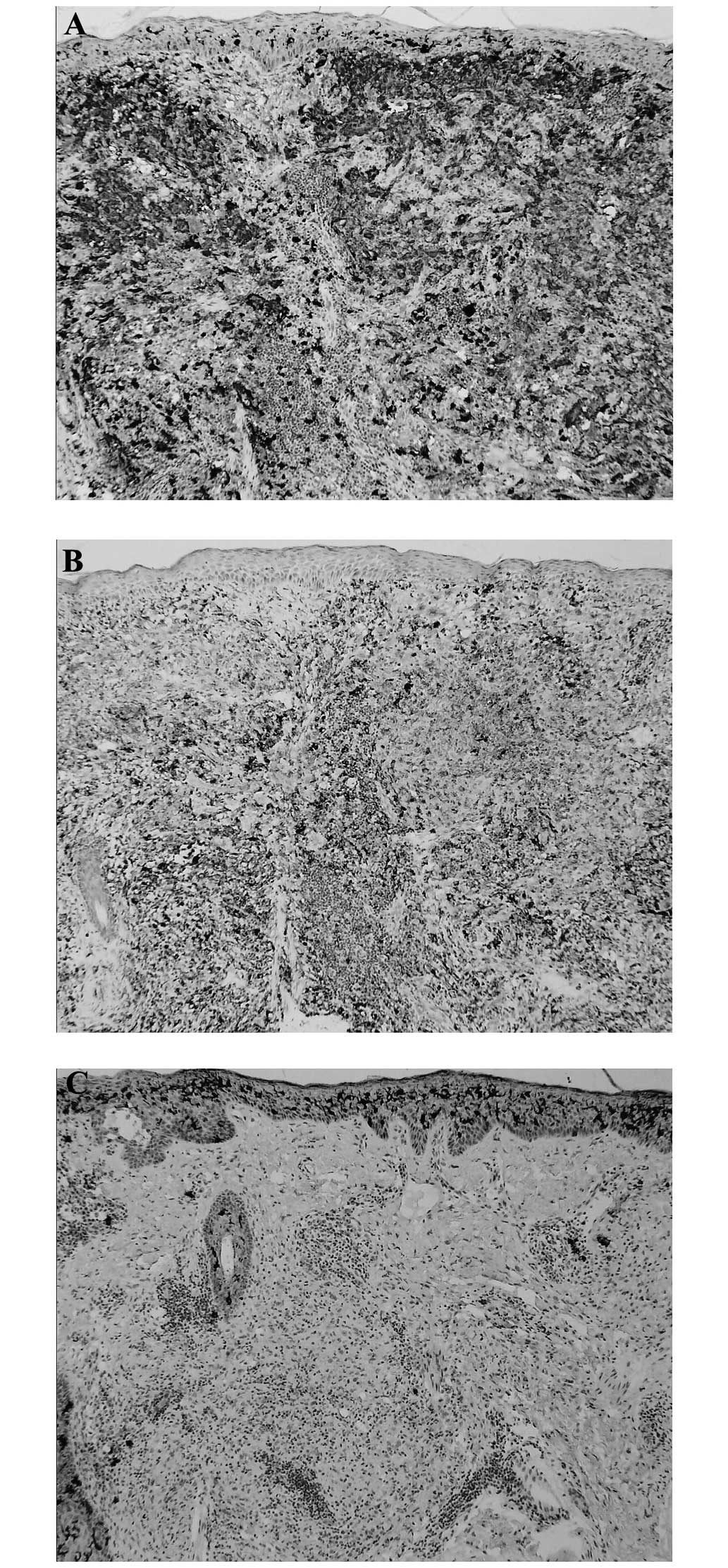Cutaneous Rosai-Dorfman disease in a middle-aged man: A case report
- Authors:
- Published online on: June 18, 2015 https://doi.org/10.3892/etm.2015.2580
- Pages: 1199-1201
Abstract
Introduction
Rosai-Dorfman disease, also known as sinus histiocytosis with massive lymphadenopathy, is a rare, idiopathic, histiocytic proliferation disorder originally defined by Rosai and Dorfman in 1969 (1). This disorder commonly presents with bilateral painless lymphadenopathy in the neck and is also associated with leukocytosis, fever, high erythrocyte sedimentation rate and polyclonal hypergammaglobulinemia (2). Between 25 and 40% of patients experience extranodal involvement, particularly on the skin (2,3), ~3% of which is limited exclusively to the skin (4), and is known as cutaneous Rosai-Dorfman disease (CRDD). To date, there have been ~100 reported cases of CRDD in the literature (5). Clinical presentation and therapeutic options of CRDD vary, and the etiology of the disease is still unknown. The clinical manifestations include single or multiple yellow-red to brown or purple papules, nodules and/or plaques, with the face being the most frequently affected site. The histological characteristics include varying numbers of polymorphous histiocytes embedded in a mixed inflammatory infiltrate composed of lymphocytes, plasma cells and/or neutrophils. The typical histiocytes have abundant lightly eosinophilic cytoplasm and vesicular nuclei and are positive for S-100 and cluster of differentiation (CD)68 but negative for CD1a. The present case report describes a case of pure CRDD in a middle-aged man.
Case report
A 52-year-old man presented with an 8-month history of multiple lesions on his face. The initial lesions comprised several asymptomatic red papules on his cheeks and forehead, the number of which slowly increased over time. Physical examination revealed clustered or satellite firm, yellowish-red papules and nodules, a number of which had coalesced into plaques exhibiting telangiectasia and an irregular surface (Fig. 1). No fever, malaise, reduced appetite, weight loss or lymphadenopathy was observed. Detailed laboratory analyses, including complete blood count, biochemical tests and serum lipoprotein profile were all in normal range. Abdominal ultrasound and chest X-ray were also negative. All of the above showed that there was no systemic involvement. A biopsy specimen from a red papule showed a dense, dermal infiltrate, which was predominantly composed of large histiocytes with vesicular nuclei and abundant pale pink cytoplasm embedded in aggregates of lymphocytes and scattered plasma cells and eosinophils (Fig. 2A and B). The histiocytes were strongly positive for S-100 and CD68 (Fig. 3A and B), but negative for CD1a (Fig. 3C). A diagnosis of CRDD was made two weeks after the patient was admitted to the clinic (Beijing Hospital, Beijing, China). The patient received oral prednisone (30 mg/day) for one month, and achieved mild remission but ultimately treatment was discontinued due to concerns about the side effects of glucocorticoids and the cost of further therapies. Informed consent was received from the patient.
Discussion
Pure CRDD has been regarded as a distinct clinical entity from typical RDD with lymphadenopathy and/or internal organ involvement with regard to its different epidemiology and the lack of systemic involvement, even with long-term follow-up (6). The disease tends to affect older Caucasian women and Asians, with the mean onset age of ~45 years (4). The clinical manifestations of CRDD include single or multiple, usually asymptomatic, yellow-red to brown or purple papules, nodules and/or plaques, which most frequently affect the face (4). The most common presentation is papulonodular clusters coalescing into verrucous plaques with surrounding satellite lesions (4). The diagnosis of CRDD rests on histopathological findings; varying numbers of polymorphous histiocytes may be observed to be embedded in a mixed inflammatory infiltrate composed of lymphocytes, plasma cells and/or neutrophils. A small number of eosinophils in the present case appeared to show reactive proliferation; however, the significance of a prominent eosinophilic infiltrate has not been elucidated (7). Representative histiocytes have abundant, lightly eosinophilic cytoplasm and vesicular nuclei, and are positive for S-100 but negative for CD1a. The presence of histiocytes with intact, phagocytosed lymphocytes, plasma cells or neutrophils (emperipolesis) is not very common in pure CRDD (8). The etiology of CRDD has been putatively linked to infectious agents, including human herpes virus 6, Epstein-Barr virus or herpes zoster virus, and immunological triggers, such as autoimmune diseases, pneumococcal vaccination and scars associated with previous surgery (9). The clinical course of the disease varies, with certain cases spontaneously resolving after months or years and others persisting despite multiple treatment efforts. Therapeutic options include surgery, radiotherapy (10), cryotherapy (11), retinoids (12), dapsone (75 mg/day) (13) or high-dose thalidomide (300 mg/day) (14), oral or intralesional corticosteroids (15), low-dose methotrexate (5,16) and imatinib (17).
The patient in the present study was a middle-aged man who exhibited the typical clinical manifestations of CRDD. The condition was slow in growth and without any indication of regression. Even though the patient showed only a marginal response to a month of low-dose prednisone (30 mg/day), he may have had a significant improvement if he was treated with retinoids or high-dose thalidomide.
References
|
Rosai J and Dorfman RF: Sinus histiocytosis with massive lymphadenopathy: A newly recognized benign clinicopathologic entity. Arch Pathol. 87:63–70. 1969.PubMed/NCBI | |
|
Foucar E, Rosai J and Dorfman R: Sinus histiocytosis with massive lymphadenopathy (Rosai-Dorfman disease): Review of the entity. Semin Diagn Pathol. 7:19–73. 1990.PubMed/NCBI | |
|
Pitamber HV and Grayson W: Five cases of cutaneous Rosai-Dorfman disease. Clin Exp Dermatol. 28:17–21. 2003. View Article : Google Scholar : PubMed/NCBI | |
|
Lu CI, Kuo TT, Wong WR and Hong HS: Clinical and histopathological spectrum of cutanous Rosai-Dorfman disease in Taiwan. J Am Acad Dermatol. 51:931–939. 2004. View Article : Google Scholar : PubMed/NCBI | |
|
Sun NZ, Galvin J and Cooper KD: Cutaneous Rosai-Dorfman disease successfully treated with low-dose methotrexate. JAMA Dermatol. 150:787–788. 2014. View Article : Google Scholar : PubMed/NCBI | |
|
Brenn T, Calonje E, Granter SR, et al: Cutaneous Rosai-Dorfman disease is a distinct clinical entity. Am J Dermatopathol. 24:385–391. 2002. View Article : Google Scholar : PubMed/NCBI | |
|
Cangelosi JJ, Prieto VG and Ivan D: Cutaneous Rosai-Dorfman disease with increased number of eosinophils: Coincidence or histologic variant? Arch Pathol Lab Med. 135:1597–1600. 2011. View Article : Google Scholar : PubMed/NCBI | |
|
Molina-Garrido MJ and Guillén-Ponce C: Extranodal Rosai-Dorfman disease with cutaneous and periodontal involvement: A rare presentation. Case Rep Oncol. 4:96–100. 2011. View Article : Google Scholar : PubMed/NCBI | |
|
Bassis AV, Fairley JA, Ameln RT and Swick BL: Cutaneous Rosai-Dorfman disease following pneumococcal vaccination. J Am Acad Dermatol. 65:890–892. 2011. View Article : Google Scholar : PubMed/NCBI | |
|
Bunick CG, Leffell D, Bosenberg M, et al: Cutaneous Rosai-Dorfman disease of the right ear responsive to radiotherapy. J Am Acad Dermatol. 67:e225–e226. 2012. View Article : Google Scholar : PubMed/NCBI | |
|
Fumerton R, Ball N and Zhou Y: Refractory cutaneous Rosai-Dorfman disease responsive to cryotherapy. Cutis. 87:296–299. 2011.PubMed/NCBI | |
|
Fening K, Bechtel M, Peters S, et al: Cutaneous Rosai-Dorfman disease persisting after surgical excision: Report of a case treated with acitretin. J Clin Aesthet Dermatol. 3:34–36. 2010.PubMed/NCBI | |
|
Chang HS, Son SJ, Cho KH and Lee JH: Therapeutic challenge of dapsone in the treatment of purely cutaneous Rosai-Dorfman disease. Clin Exp Dermatol. 36:420–422. 2011. View Article : Google Scholar : PubMed/NCBI | |
|
Tjiu JW, Hsiao CH and Tsai TF: Cutaneous Rosai-Dorfman disease: Remission with thalidomide treatment. Br J Dermatol. 148:1060–1061. 2003. View Article : Google Scholar : PubMed/NCBI | |
|
Oka M, Kamo T, Goto N, et al: Successful treatment of Rosai-Dorfman disease with low-dose oral corticosteroid. J Dermatol. 36:237–240. 2009. View Article : Google Scholar : PubMed/NCBI | |
|
Nadal M, Kervarrec T, Machet MC, et al: Cutaneous Rosai-Dorfman disease located on the breast: Rapid effectiveness of methotrexate after failure of topical corticosteroids, acitretin and thalidomide. Acta Derm Venereol. Jan 29–2015.(Epub ahead of print). View Article : Google Scholar : PubMed/NCBI | |
|
Gebhardt C, Averbeck M, Paasch U, et al: A case of cutaneous Rosai-Dorfman disease refractory to imatinib therapy. Arch Dermatol. 145:571–574. 2009. View Article : Google Scholar : PubMed/NCBI |












